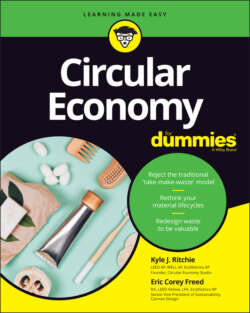Читать книгу Circular Economy For Dummies - Eric Corey Freed - Страница 32
Upcycling versus downcycling
ОглавлениеTechnical materials as well as biological ones can be made into new products that are either more or less valuable than their original use. Glass bottles can be upcycled into more valuable pieces of artwork and shattered to form mosaic art, or they can be downcycled instead to act as an aggregate in a kitchen counter. In either instance, value is created by maintaining the use of the product rather than disposing of it.
Upcycling is a strategy that reuses a product in a way that holds more value than the original product, whereas downcycling reuses a product in a way that holds less value than the original product. Though at first the idea of downcycling a product may seem valueless, downcycling is still advantageous because it’s a better alternative to recycling or disposal. The idea of upcycling or downcycling materials into new products, as a concept, is a critical component of supporting a circular economy. However, if you don't provide the right infrastructure, individuals and institutions won’t have the means to support this strategy of extended use.
Large subcultures of makers — that range of designers, builders, and crafters — are booming around the world, and the spaces they use provide the very infrastructure and tools necessary to promote upcycling and downcycling. By providing access to computer numerical control (CNC) machines, 3D printers, and other technologies, makers now have more power than ever to maximize the value of their products by repurposing them.
